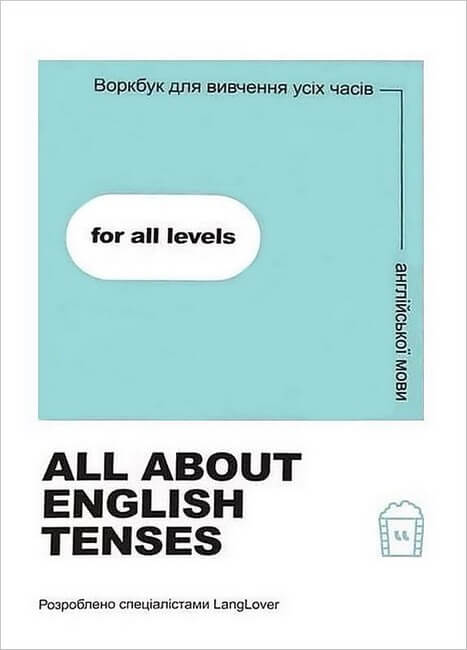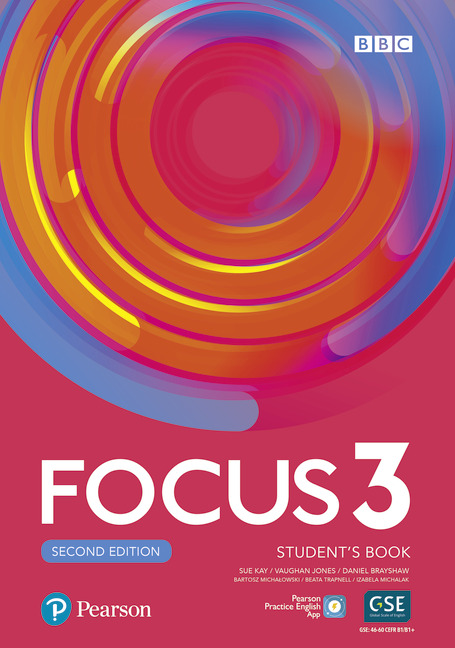Tenses in English for children
Oleksandra Kulish
Book expert
English tenses can seem complicated, especially when it comes to explaining the rules correctly to children at the very beginning of their learning journey. Each of them has its own peculiarity and is used in specific situations. So how do you not only understand them, but also learn them without mechanical memorization? Let's take a closer look at the theory and find new ways to master tenses in English for children using secondary school English textbooks.
How many tenses are there in English?

Unlike Ukrainian, where there are only three main tenses (past, present and future), English has 12 main tenses. They are divided into three main groups - Present, Past and Future. In addition, each group has four subgroups, each of which is a separate form of tense with its own characteristics and rules of use. The names of these subgroups are Simple, Continuous, Perfect, and Perfect Continuous. It is the combinations of groups and forms that make up the 12 tenses of the English language.
Table of English tenses with examples
The principle of forming English tenses is quite simple. The formula itself always consists of the subject, the auxiliary verb “to be” and the main verb in the appropriate form (ending in a certain time or in the appropriate form, which you need to know by heart). For detailed examples, see the table below.
|
Time |
Formula |
Example |
|
Present Simple |
subject + verb + object |
I watch movies. |
|
Present Continuous |
subject + am/is/are + verb -ing + object |
I am watching a movie. |
|
Present Perfect |
subject + have/has + past participle + object |
I have watched the movie. |
|
Present Perfect Continuous |
subject + have/has + been + verb -ing + object |
I have been watching the movie for two hours. |
|
Past Simple |
subject + verb past form + object |
I watched a movie yesterday. |
|
Past Continuous |
subject + was/were + verb -ing + object |
I was watching the movie when you called. |
|
Past Perfect |
subject + had + past participle + object |
I had watched the movie before I went to bed. |
|
Past Perfect Continuous |
subject + had + been + verb -ing + object |
I had been watching the movie for an hour before you called. |
|
Future Simple |
subject + will + verb + object |
I will watch a movie tomorrow. |
|
Future Continuous |
subject + will be + verb -ing + object |
I will be watching the movie at 8 PM. |
|
Future Perfect |
subject + will have + past participle + object |
I will have watched the movie by tomorrow. |
|
Future Perfect Continuous |
subject + will + have + been + verb -ing + object |
I will have been watching the movie for two hours by then. |
Choosing the right formula helps to convey the meaning of your statement more accurately. Let's look at how to use the correct verb form.
Peculiarities of using verb forms in English

When choosing a verb form, a native speaker pays attention to when the action takes place and its duration. Here are examples of the main forms you need to know and when they are used:
- The infinitive is an impersonal initial or base form. Its peculiarity is that it remains unchanged. It is used in the present tense or in certain grammatical constructions.
- The past tense - the so-called Past form - is used to emphasize that an action took place in the past. In this case, you need to use the special ending -ed or a special form for irregular verbs (V3).
- The perfect is extremely important for the correct use of the Present Perfect, Past Perfect, and Future Perfect. Here you will also need the -ed ending or the V3 form of irregular verbs.
- Present participle (with the ending -ing) is the form of all Continuous tenses that always indicates the duration of an action.
For confident use of the first three forms for children, English textbooks for elementary school are ideal. For a detailed analysis of the Past Participle, it is best to consider learning materials from the B1 level.
Common uses of tenses
Knowing when to use different tenses will help you convey the meaning of a particular statement. Let's look at the most popular uses.
- Present Simple - habits and regular activities, general facts, schedules and timetables.
- Present Continuous - an action that is happening at the moment of speaking.
- Present Perfect - an action that began in the past but is related to the present or took place at an indefinite time.
- Present Perfect Continuous - an action that began in the past and is still going on.
- Past Simple - a completed action or sequence of events in the past.
- Past Continuous - used for actions that took place at a certain point in the past; parallel actions in the past.
- Past Perfect - an action that happened before another in the past.
- Past Perfect Continuous - an action that lasted until a specific moment in the past.
- Future Simple - predictions about the future. Indicates promises, intentions, and decisions made at the time of speaking.
- Future Continuous - an action that will take place at a certain point in the future. Indicates parallel actions in the future.
- Future Perfect - an action that will be completed by a certain time in the future
- Future Perfect Continuous - actions that will continue until a certain point or before another event in the future.
It can be difficult to memorize so many tenses and conditions, but with practice, it is quite possible.
How to memorize all the main tenses of English quickly?
Children often learn grammar worse than vocabulary. This is because English rules are so different from Ukrainian ones. However, there are several effective methods for learning tenses without the mechanical memorization that children are used to at school:
- The most interactive and interesting method is watching your favorite cartoons and TV shows and listening to trendy music in English. This will help them learn how native English speakers use the tenses.
- Of course, you can't do it without repetition. But you can replace the usual format and create flashcards with words and sentences in the appropriate tense.
- Making real-life associations between a tense and a specific rule for using it will also help. Train schedules are Present Simple, a list of vacation plans is Future Simple, and so on.
A prerequisite for effective learning of the tenses such as Past, Present, Future Simple for children is not just tables and formulas. The English language should be associated with something pleasant, not irritating.
How can you easily remember verb forms?
Here's how to easily remember verb forms in English:
- Infinitive: this is the basic form (to go, to play) — learn it in combination with the translation and examples in sentences.
- Past Simple: for irregular verbs — group them by similar forms (come–came, run–ran), for regular verbs — just add -ed.
- Past Participle: often coincides with Past Simple (played–played), or differs (go–gone) — learn them in triads: go–went–gone.
- Present Participle: add -ing to the infinitive (play → playing), learn in sentences: I am playing.
Tip: learn forms in context, through sentences or stories, rather than in isolation. This will speed up memorisation.
A humorous memo on the use of English tenses

As you know, children have a very developed imagination. This is something that can be used for good when classical learning systems no longer work. Learning something in a playful way is something that makes it easier for a child to grasp the English tenses.
Ask your child to imagine a lazy cat and illustrate his or her usual day together. Use the learned forms as follows:
- Present Simple - My cat eats fish every day.
- Present Continuous - My cat is sleeping on the sofa right now.
- Past Simple - My cat played with the ball yesterday.
Using and learning humorous structures and fun characters is a great creative way to have fun in English.
From theory to practice: exercises for reinforcement
To successfully reinforce your knowledge of grammar and verb tenses, it is important to move from theoretical rules to practical exercises on the Present Simple and Present Continuous for children. Practice helps not only to better understand the past, future and present tenses in English for children, but also to learn how to use them quickly and correctly in speech. Here are some effective exercises to help you consolidate verb forms and learn to use them confidently.
- “My day in hours.” A simple and straightforward exercise where you describe your typical day using different verb tenses, such as Present Simple, Past Simple or Future Simple. This approach allows you to link grammatical structures into coherent speech and actively develop your vocabulary.
- “Detective with markers.” When you read (or listen, depending on the format) a short story, you need to find and underline time markers such as “yesterday,” “already,” “just,” “every day.” This exercise helps you to better orient yourself in time and understand which verbs are used in certain situations.
- “Alibi.” In this exercise, one participant plays the role of a suspect, and the others ask him questions in the past tense (Past Simple or Past Continuous) to verify the truth of his alibi. This dynamic game helps develop conversation skills and quick thinking.
- “Making up stories with pictures.” Choose several pictures and try to make up an interesting story based on them, using different grammatical structures. This develops creative thinking and allows you to practise using verbs in different tenses and contexts, which is great for developing children's understanding of the Present Simple and Present Continuous.
Regularly doing these exercises will not only help you memorise verb forms better, but also learn to use them easily and confidently in everyday communication.
Let's sort out the nuances: similar but different tenses
|
Time |
When to use |
Example and explanation |
|
Past Simple |
For actions that took place at a specific moment in the past and are now complete |
I visited Paris last year. — I visited Paris last year (a specific moment in the past). |
|
Present Perfect |
For actions that happened in the past but are connected to the present or the result is still important |
I have visited Paris. — I have been to Paris (experience in life, no specific time, important now). |
|
Present Perfect Continuous |
For actions that began in the past, are still ongoing or have recently ended and have an impact on the present |
I have been studying for two hours. — I have been studying for two hours (the process is ongoing or has recently ended). |
Exercises with Dinternal Education books
To help children learn Present Simple, Present Continuous, and Past Simple better, it is important to use textbooks that provide not only a clear explanation of the rules, but also effective practical exercises. The books we offer at Dinternal Education make it easy to learn grammar in practice with interesting tasks and relevant examples in real English.
Our store offers high-quality literature from leading publishers, including Pearson Education Ltd. This guarantees an exciting and effective learning process for you and your children.
Order textbooks from our assortment and learning the English tenses will become not only effective, but also interesting.










